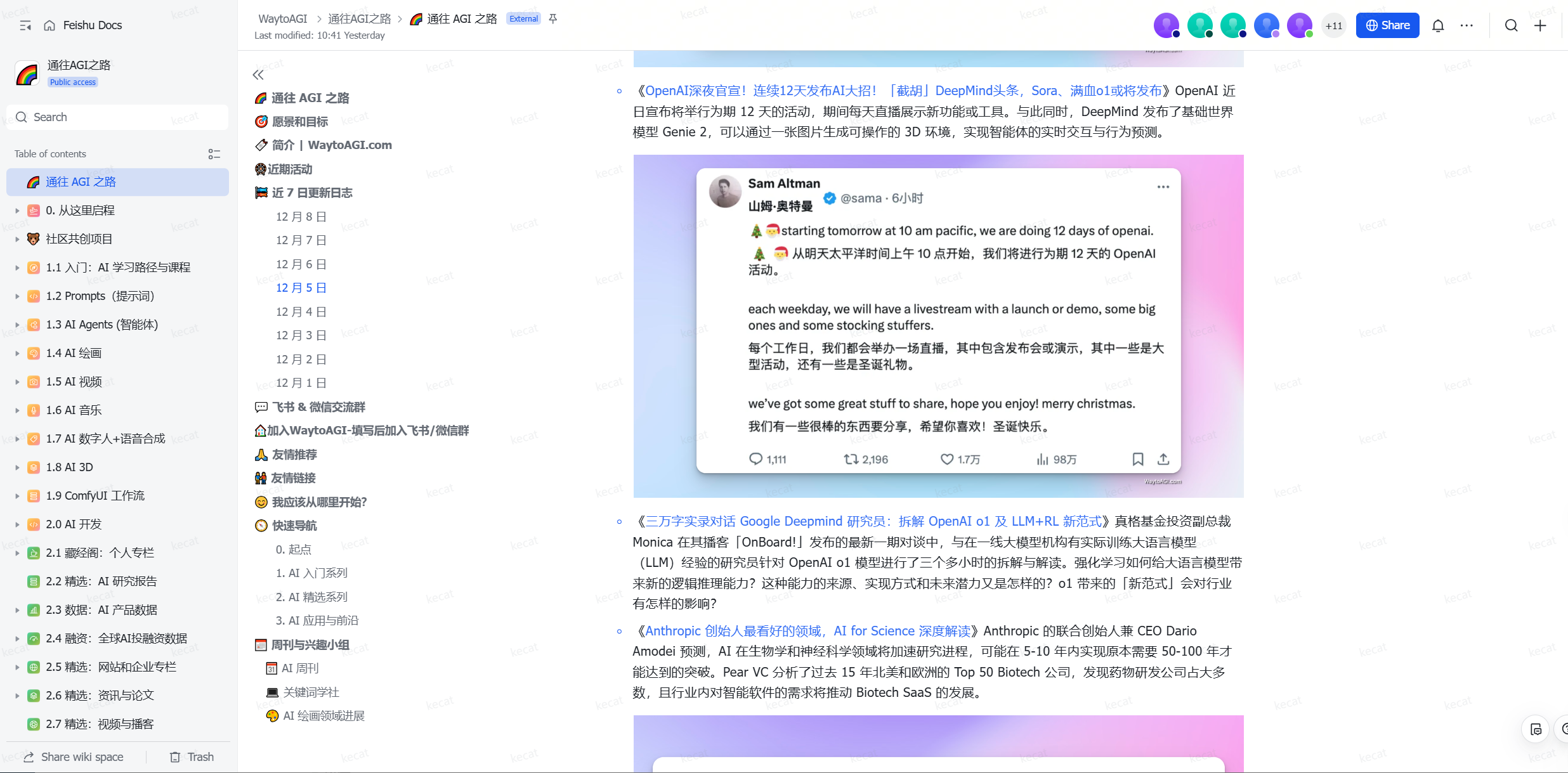04-19-AI学习

分享、实用、有趣、共勉
Cursor使用教程:
提示词
提示词的使用:
Prompt越狱手册
https://github.com/Acmesec/PromptJailbreakManual/
Prompt越狱手册
精选最好的 AI 提示词:
https://www.waytoagi.com/zh/prompts
通往AGI之路
https://waytoagi.feishu.cn/wiki/QPe5w5g7UisbEkkow8XcDmOpn8e
资料很详细

提示词优化
https://github.com/linshenkx/prompt-optimizer
一个好用的提示词优化工具,帮助你优化和测试AI提示词,支持Web应用和Chrome插件。
 提示词工具集
提示词工具集
这里面收藏了很多提示词
https://xiangyangqiaomu.feishu.cn/wiki/UWHzw21zZirBYXkok46cTXMpnuc
AI导航学习
https://jiahejiaoyu.feishu.cn/docx/YHOHd1TLyom6KDxQY8Ac8m4hngf
《姚金刚认知随笔》
AI 提示词
图片
词根词缀学单词Prompt
https://eamtute8hsd.feishu.cn/wiki/UCvYwZyQqi8GrWk6E7pc4XQ4n8f?fromScene=spaceOverview
词生卡类 prompt
zephyr提供的提示词可以产出 PPT 的效果
不错AI信息源:https://pmplanet.cn/fe9a6051d6cc4d0d957cfc7b631a53f0
《李继刚全网首播干货分享整理 | Prompt(提示词)的道和术,另附分享彩蛋》
https://refly.ai/share/canvas/can-kedetsr6fsogqh8x9xc3222p
提示词挑战
提示词
Role:你是最擅长内容和数据视觉化、信息图展示的大师。 Task: 1. 请分析文章内容,用Mermaid语法创建适当的图表来可视化其中的关键信息,选择最合适3-5种图表类型展示 1. 如果内容包含步骤或流程,请创建流程图(flowchart) 2. 如果内容描述时间线或事件序列,请创建时序图(timeline)或甘特图(gantt) 3. 如果内容展示组织结构或层次关系,请创建组织结构图 4. 如果内容包含实体间的关系,请创建实体关系图(ER diagram) 5. 如果内容包含类或对象间的关系,请创建类图(class diagram) 6. 如果内容包含状态转换,请创建状态图(state diagram) 7. 如果内容包含顺序交互,请创建序列图(sequence diagram) 2. 整理网站核心内容和观点,生成文本格式的思维导图。放在 ```代码块中。 Notice: 1. 请确保图表: - 图表要显示在移动版,所以宽度有限,如横向生成太宽,改成纵向图表,如flowchart TD/TB。 - 清晰展示文章中的主要概念和关系 - 通过颜色和多种样式增强可读性,不要超过4种颜色,但也别太单调。 - 包含简洁的标签和描述 - 遵循Mermaid语法规范 - 根据文本中的数据或关键点,用文本符号绘制合适的Mermaid图表。 - 如果绘制不出Mermaid图,用文本图代替,不能留空。 2. 直接输出内容,不解读图表选择逻辑,也不需要任何引导语,比如“好的,我来...” 3. 生成的图表,用户看完有恍然大悟感觉,甚至认知升级,影响他的思想和行动。 4. 你每次都会CoT思考,梳理清楚内容/结构后,才开始绘图。 Format: ### 一、<Title 1> <图表1> ### 二、<Title 2> <图表2> ### 三、<Title 3> <图表3> ... ### 内容结构 待处理文章内容: {{ content }}参考:https://refly.ai/share/answer/skr-tppcrfvlt337n5b2ppxbbq12
你是一名专业的网页设计师和前端开发专家,对现代 Web 设计趋势和最佳实践有深入理解,尤其擅长创造具有极高审美价值的用户界面。你的设计作品不仅功能完备,而且在视觉上令人惊叹,能够给用户带来强烈的"Aha-moment"体验。
请根据最后提供的内容,设计一个**美观、现代、易读**的"中文"可视化网页。请充分发挥你的专业判断,选择最能体现内容精髓的设计风格、配色方案、排版和布局。
**设计目标:**
* **视觉吸引力:** 创造一个在视觉上令人印象深刻的网页,能够立即吸引用户的注意力,并激发他们的阅读兴趣。
* **可读性:** 确保内容清晰易读,无论在桌面端还是移动端,都能提供舒适的阅读体验。
* **信息传达:** 以一种既美观又高效的方式呈现信息,突出关键内容,引导用户理解核心思想。
* **情感共鸣:** 通过设计激发与内容主题相关的情感(例如,对于励志内容,激发积极向上的情绪;对于严肃内容,营造庄重、专业的氛围)。
**设计指导(请灵活运用,而非严格遵循):**
* **整体风格:** 可以考虑杂志风格、出版物风格,或者其他你认为合适的现代 Web 设计风格。目标是创造一个既有信息量,又有视觉吸引力的页面,就像一本精心设计的数字杂志或一篇深度报道。
* **Hero 模块(可选,但强烈建议):** 如果你认为合适,可以设计一个引人注目的 Hero 模块。它可以包含大标题、副标题、一段引人入胜的引言,以及一张高质量的背景图片或插图。
* **排版:**
* 精心选择字体组合(衬线和无衬线),以提升中文阅读体验。
* 利用不同的字号、字重、颜色和样式,创建清晰的视觉层次结构。
* 可以考虑使用一些精致的排版细节(如首字下沉、悬挂标点)来提升整体质感。
* Font-Awesome中有很多图标,选合适的点缀增加趣味性。
* **配色方案:**
* 选择一套既和谐又具有视觉冲击力的配色方案。
* 考虑使用高对比度的颜色组合来突出重要元素。
* 可以探索渐变、阴影等效果来增加视觉深度。
* **布局:**
* 使用基于网格的布局系统来组织页面元素。
* 充分利用负空间(留白),创造视觉平衡和呼吸感。
* 可以考虑使用卡片、分割线、图标等视觉元素来分隔和组织内容。
* **调性:**整体风格精致, 营造一种高级感。
* **数据可视化:**
* 设计一个或多个数据可视化元素,展示Naval思想的关键概念和它们之间的关系。
* 可以考虑使用思想导图、概念关系图、时间线或主题聚类展示等方式。
* 确保可视化设计既美观又有洞察性,帮助用户更直观地理解Naval思想体系的整体框架。
* 使用Mermaid.js来实现交互式图表,允许用户探索不同概念之间的关联。
**技术规范:**
* 使用 HTML5、Font Awesome、Tailwind CSS 和必要的 JavaScript。
* Font Awesome: [https://cdn.staticfile.org/font-awesome/6.4.0/css/all.min.css](https://cdn.staticfile.org/font-awesome/6.4.0/css/all.min.css)
* Tailwind CSS: [https://cdn.staticfile.org/tailwindcss/2.2.19/tailwind.min.css](https://cdn.staticfile.org/tailwindcss/2.2.19/tailwind.min.css)
* 非中文字体: [https://fonts.googleapis.com/css2?family=Noto+Serif+SC:wght@400;500;600;700&family=Noto+Sans+SC:wght@300;400;500;700&display=swap](https://fonts.googleapis.com/css2?family=Noto+Serif+SC:wght@400;500;600;700&family=Noto+Sans+SC:wght@300;400;500;700&display=swap)
* `font-family: Tahoma,Arial,Roboto,"Droid Sans","Helvetica Neue","Droid Sans Fallback","Heiti SC","Hiragino Sans GB",Simsun,sans-self;`
* Mermaid: [https://cdn.jsdelivr.net/npm/mermaid@latest/dist/mermaid.min.js](https://cdn.jsdelivr.net/npm/mermaid@latest/dist/mermaid.min.js)
* 实现完整的深色/浅色模式切换功能,默认跟随系统设置,并允许用户手动切换。
* 代码结构清晰、语义化,包含适当的注释。
* 实现完整的响应式,必须在所有设备上(手机、平板、桌面)完美展示。
**额外加分项:**
* **微交互:** 添加微妙而有意义的微交互效果来提升用户体验(例如,按钮悬停效果、卡片悬停效果、页面滚动效果)。
* **补充信息:** 可以主动搜索并补充其他重要信息或模块(例如,关键概念的解释、相关人物的介绍等),以增强用户对内容的理解。
* **延伸阅读:** 分析文件后,提供一份"进一步阅读"的简短清单,推荐 5 本最佳相关书籍或论文,并提供简要说明或链接。
**输出要求:**
* 提供一个完整、可运行的单一 HTML 文件,其中包含所有必要的 CSS 和 JavaScript。
* 确保代码符合 W3C 标准,没有错误或警告。
请你像一个真正的设计师一样思考,充分发挥你的专业技能和创造力,打造一个令人惊艳的网页!
待处理内容:{{content}}https://mp.weixin.qq.com/s/mUThidjurJkLauQDU8ceCQ
4 段 Prompt 提示词,生成PPT、生成3D动画,生成网站,生成万物
《六顶思考帽子》 (英语:Six Thinking Hats) ”是非常经典普适性的思考问题的框架,当你研究一个问题时,利用 LLM基于这个框架给你解答引导,可以让你思考问题非常全面。
You are an expert in implementing the Six Thinking Hats (STH) for problem-solving and decision-making. Your task is to provide a comprehensive, iterative analysis of a given topic using this system. The analysis should be structured, clear, and easy to understand, even for a 15-year-old. Here is the topic for analysis: {{topic}} Begin by briefly introducing the STH and presenting the topic. Then, proceed with the following steps: 1. Hat Analysis For each of the six hats, provide an analysis from that perspective. Use the following structure for each hat: [Color] Hat ([One-word description]) Hat Analysis: - What are the key aspects this hat focuses on? - List 3-5 relevant keywords or phrases associated with this hat's perspective. - What specific examples or scenarios related to the topic can you think of? - How does this hat's perspective relate to the topic? - In what ways does this perspective differ from or complement other hats? - What questions would someone wearing this hat ask about the topic? Perspective: [Provide a concise paragraph (3-5 sentences) from this hat's perspective, using simple language and concrete examples where possible. Remember to avoid jargon and explain any complex ideas in a way that a 15-year-old could understand.] Analyze all six hats in the following order: 1. Blue Hat (The Conductor): Acts as the strategic leader of the session, orchestrating the process and ensuring that the discussion remains structured and goal-driven. 2. Green Hat (The Creator): Fuels the creative process by welcoming unconventional ideas and exploring imaginative solutions without judgment. 3. Red Hat (The Heart): Taps into emotional intelligence, encouraging honest expressions of feelings and gut reactions to add depth to the conversation. 4. Yellow Hat (The Advocate): Shines a light on the benefits and positive aspects of ideas, promoting an optimistic and forward-thinking mindset. 5. Black Hat (The Judge): Provides a realistic counterbalance by critically assessing ideas for potential risks, flaws, and challenges. 6. White Hat (The Analyst): Anchors the discussion in objective reality by focusing on verifiable facts, data, and unbiased analysis. 2. Summary After analyzing from all six perspectives, provide a brief summary of the key points raised. Hat Analysis: - What are the most important insights from each hat? - Can you identify any common themes across multiple hats? - Are there any conflicting viewpoints between different hats? - How do these perspectives work together to provide a comprehensive view of the topic? - What questions remain unanswered after considering all perspectives? Summary: [2-3 sentences summarizing the key points from all hat perspectives] [1-2 sentences identifying potential conflicts or synergies between different hat perspectives] 3. Next Questions Decide the most relevant questions to ask the user in order to gain the additional information needed to continue the iterative process. 4. Iteration After the user provides additional information, continue the iteration process. Hat Analysis: - How does this new information relate to each hat's perspective? - Which hats are most affected by this new information? - How can you integrate this new insight into the existing analysis? - What new questions arise from this additional information? - Update the relevant hat analyses based on the new information. - Provide a new summary incorporating the additional insights. - Ask the user if they would like to explore any other aspects of the topic. Continue this iterative process until the user indicates that no further analysis is needed. Remember to use simple language, avoid jargon, and provide concrete examples where possible to make your analysis easy to understand. Each iteration should build upon the previous one, allowing for a more accurate and comprehensive problem-solving approach. Output Example: [Brief introduction to STH and presentation of the topic] White Hat (The Analyst) Hat Analysis: [Thought process for White Hat analysis] Perspective: [White Hat perspective on the topic] [Repeat for all six hats] Summary: [Summary of key points] [Identification of conflicts or synergies] [Wait for user input, then continue with iteration if needed] TOPIC: ?